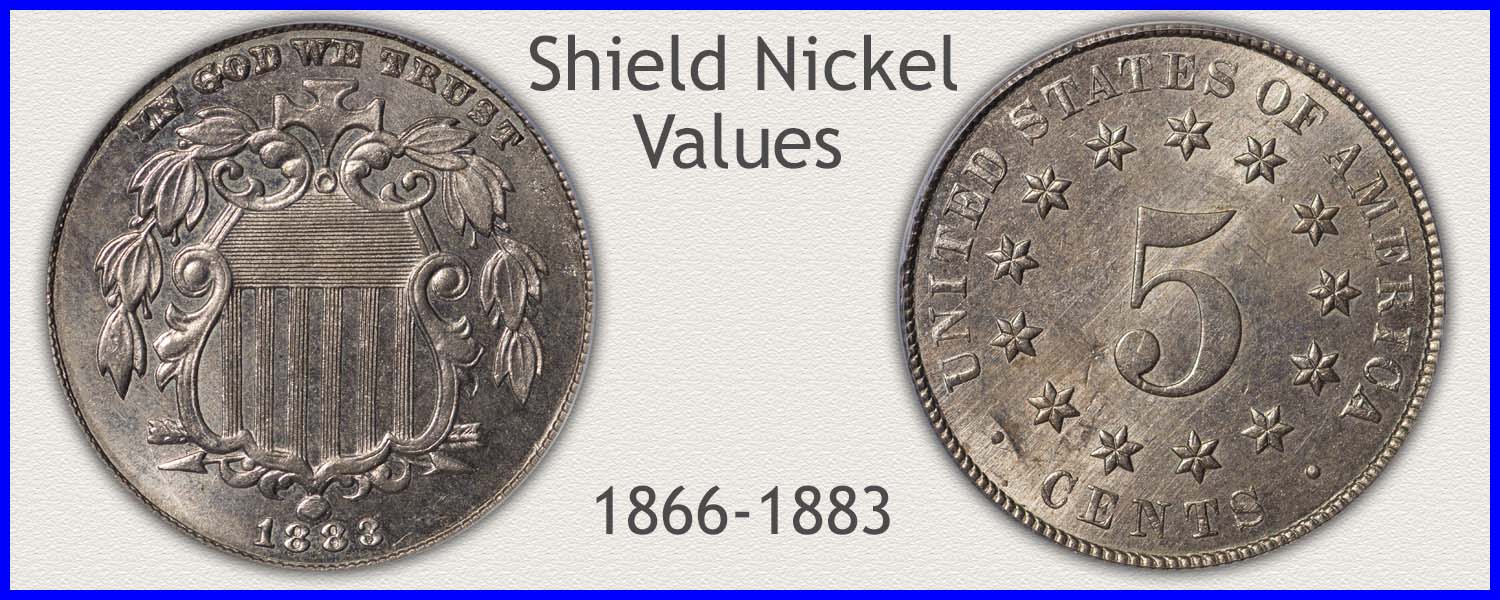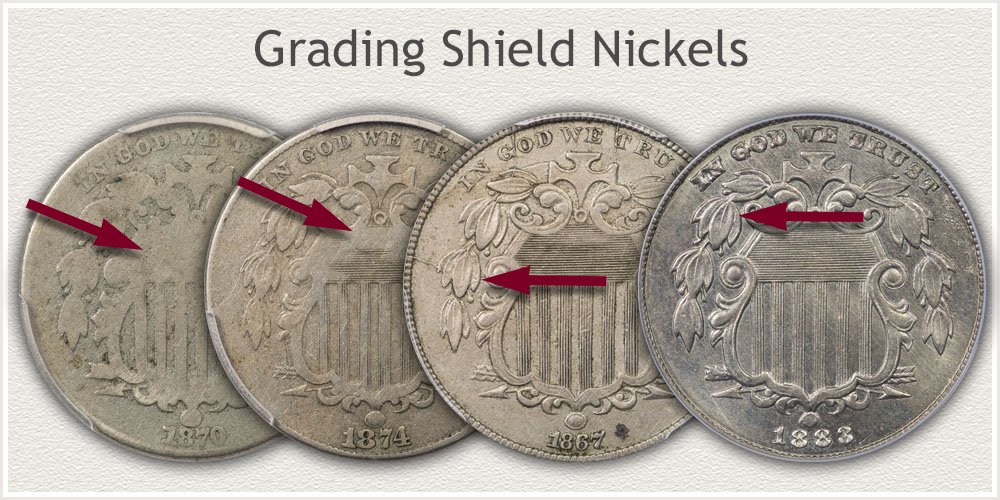Coin Values Moving with Precious Metals: Up-Dated 12/15/2025: Gold $4341 | Silver $63.26
1867 Nickel Value
An accurate 1867 nickel value considers two varieties minted that year. An effort to improve quality during production required a new reverse design. The first design of the year featured a large five with rays between the stars. Removing the rays mid-year created the second design. Using the step-by-step process below, identify these separate varieties.
After identifying the variety, judging the condition of the coin is the next important step. Images plus detailed descriptions help with a decision.
Starting with the value chart, this lists a range of how much an 1867 nickel is worth. Importantly, each variety shows a different value progression.
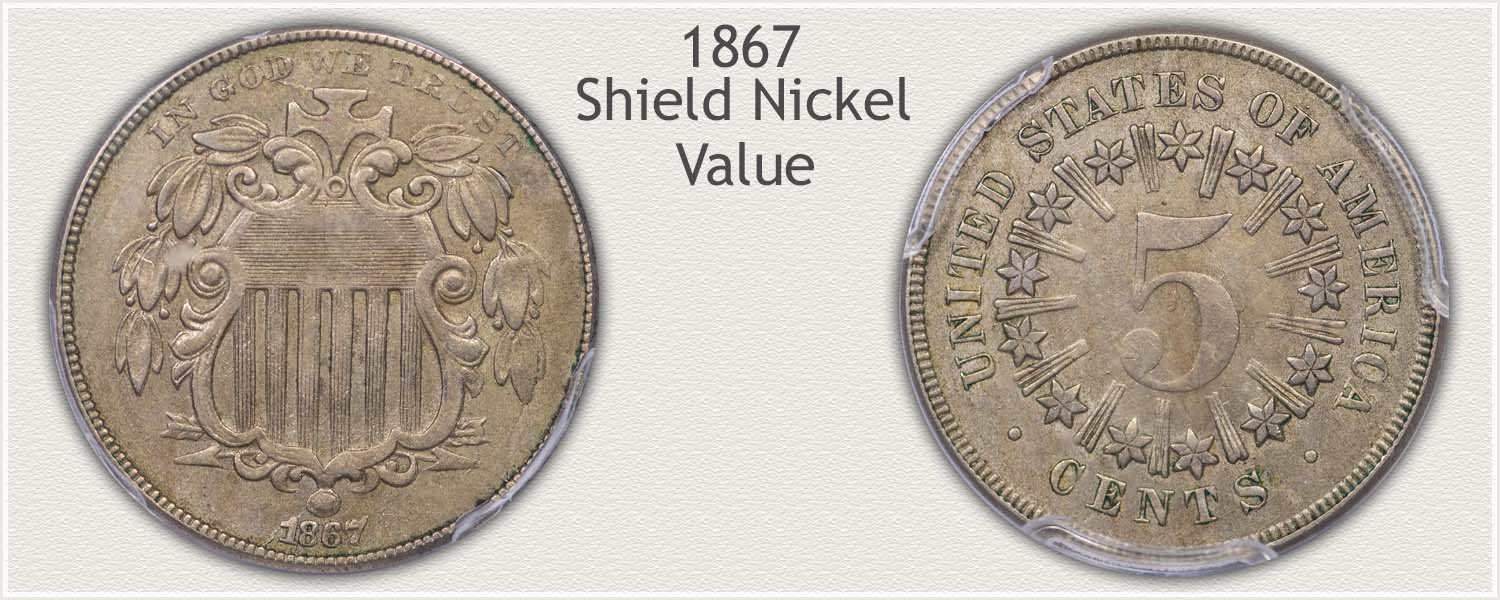
Steps Leading to Value:
- Step 1: Date Identified - Record the correct date and variety creating an accurate description. This is a popular coin to identify.
- Step 2: Grading Condition - In the coin hobby, different levels of preservation appeal to certain collectors. Narrow the condition range finding its demand and premium.
- Step 3: Special Qualities - A change in design creates interest in the coin market. The "original" and "replacement" designs have different scarcity ratings. This scarcity plus demand plays a role in their values.
| 1867 Nickel Value | ||||
|---|---|---|---|---|
| Condition of Coin | ||||
| Date | Good | Fine | Extremely Fine |
Mint State |
| 1867 Nickel Value Updated | 2025 | |||
| Type I: Rays on Reverse | ||||
| 1867 Rays | $23 | $55 | $154 | $304 |
| Type II: Without Rays on Reverse | ||||
| 1867 No Rays | $20 | $27 | $59 | $119 |
The above chart lists a range of wholesale values these nickels trade within the market. Note, because of scarcity, small improvements in preservation have an impact on premiums.
Step 1: 1867 is a Two Variety Year of the Shield Nickel Series
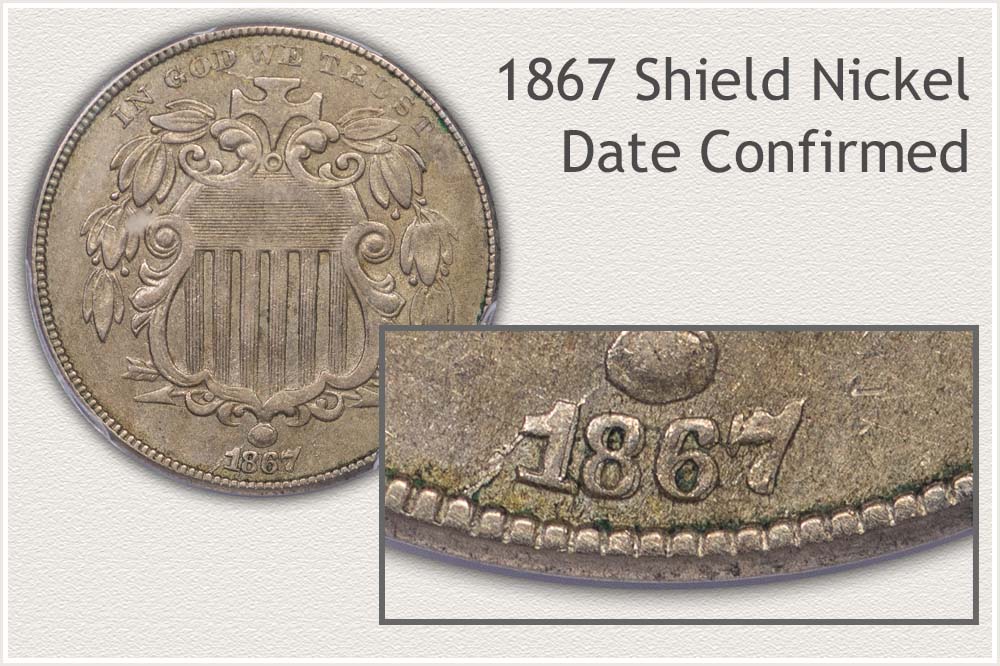
1867 nickels are the second year of the Shield nickel series. Interestingly, it is a year introducing a distinct design change. Partway into production, removing the "Rays" enhanced the quality of the strike. Step 3 below goes into visual detail, illustrating the different reverse varieties.
In total, over 30 million 1867 nickels entered circulation. A year notable as the highest mintage of any Shield nickel. Its scarcity profile favors the "Rays" variety as the value leader. The original "Rays" variety was only minted for a short time early in the year, resulting in its premium. Not lost in significance, the "Without Rays" variety represents the first year of a new design. The year 1867 is highly collectible for both varieties of the series.
Find the date on the "Shield" side. Inspect below the Shield to confirm the date.
Step 2: | Recognizing Stages of Wear Determines the Grade
Comparing to Grading Images Narrows 1867 Nickel Value
To find its specific place on the value chart, compare the coin to the grading images. These close-up illustrations represent the different stages of wear. Collectors and dealers define a coin's condition using a grading scale. The term "Good" grade defines a coin with heavy wear. Mint State coins are without wear. Many various stages of wear between heavy and no wear exist, each given a grade. Grading identifies and judges specific details required to meet each grade standard.
The illustrations give a good overall view of these different grades. Highlighted by the descriptions, focus on the small details needed to meet the grade. Many fine design elements are on the obverse of a Shield nickel. These also have high and low relief, providing a good measurement of wear amounts.
Mint State Grade
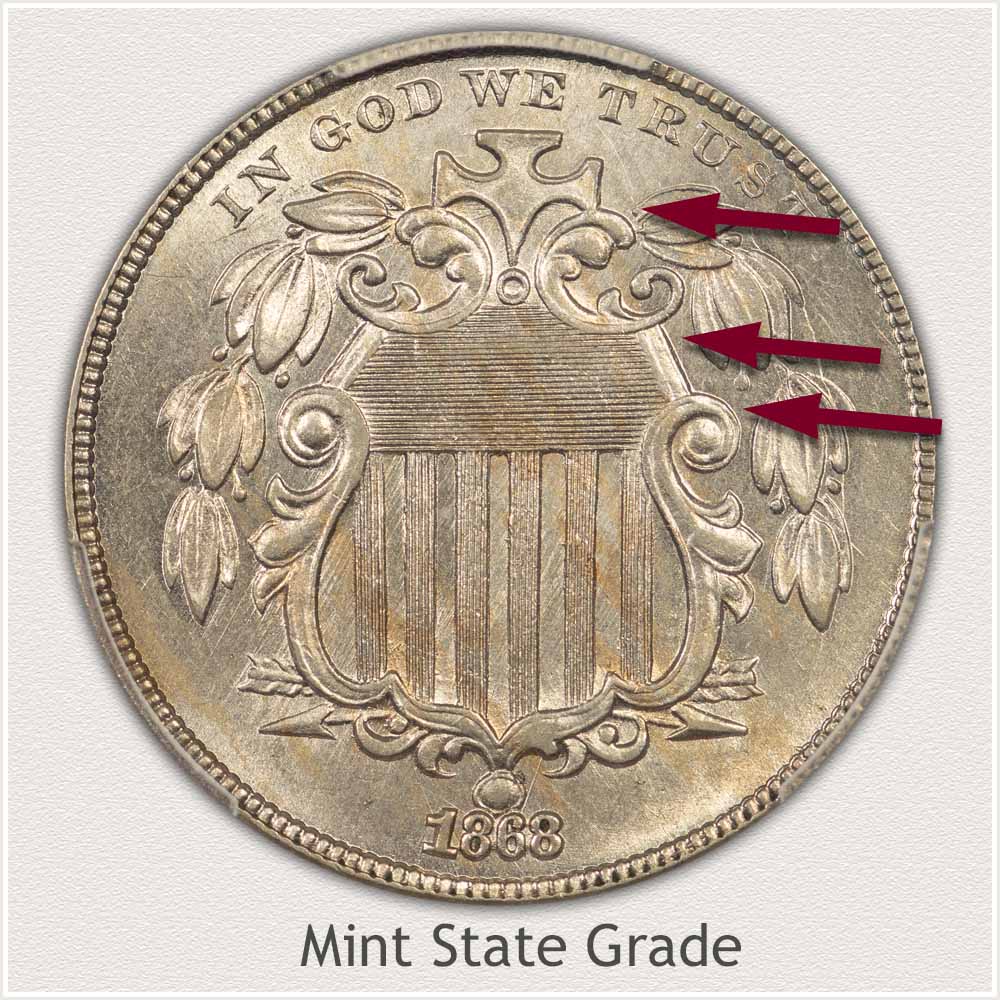
Mint State: How to confirm a Mint State Shield nickel starts by examining high points of the design. No wear on the surface of the coin defines the Mint State grade. Using a standard grading approach, compare high to low areas. Look for a similar quality surface. A fine grain texture covers coins without wear. This texture, the result of the minting process, radiates outward from the center. It produces a glow of luster as it reflects light. Its delicate nature quickly wears away as a coin is handled in circulation.
Inspect the frame device surrounding the horizontal and vertical lines. These large, curved, and rounded features are high and low areas. Also, small, raised edging provides areas to inspect. Look for any signs of flattening on the tops of larger areas. Any flatness indicates missing original texture, and wear has removed metal.
On the right side of the example, the frame near the bottom of the horizontal lines is intact. All the contours remain fully rounded. Surface texture of lower recesses matches the tops of contours. Also, fine line edging is crisp without any flattening from wear. Using these metrics, examine the frame above the horizontal lines. All rounded and curved features show no signs of smooth or flattened metal.
A close inspection judges these two frame areas of the design appear similar in quality. Both the right side and top elements display nice, matching luster. A shine of luster remains on high and low points. Grading a coin under a single light highlights the glow of luster. Worn metal reflects less light and appears dull. A close match of your coin to the example coin identifies a high-quality Shield nickel.
Extremely Fine Grade
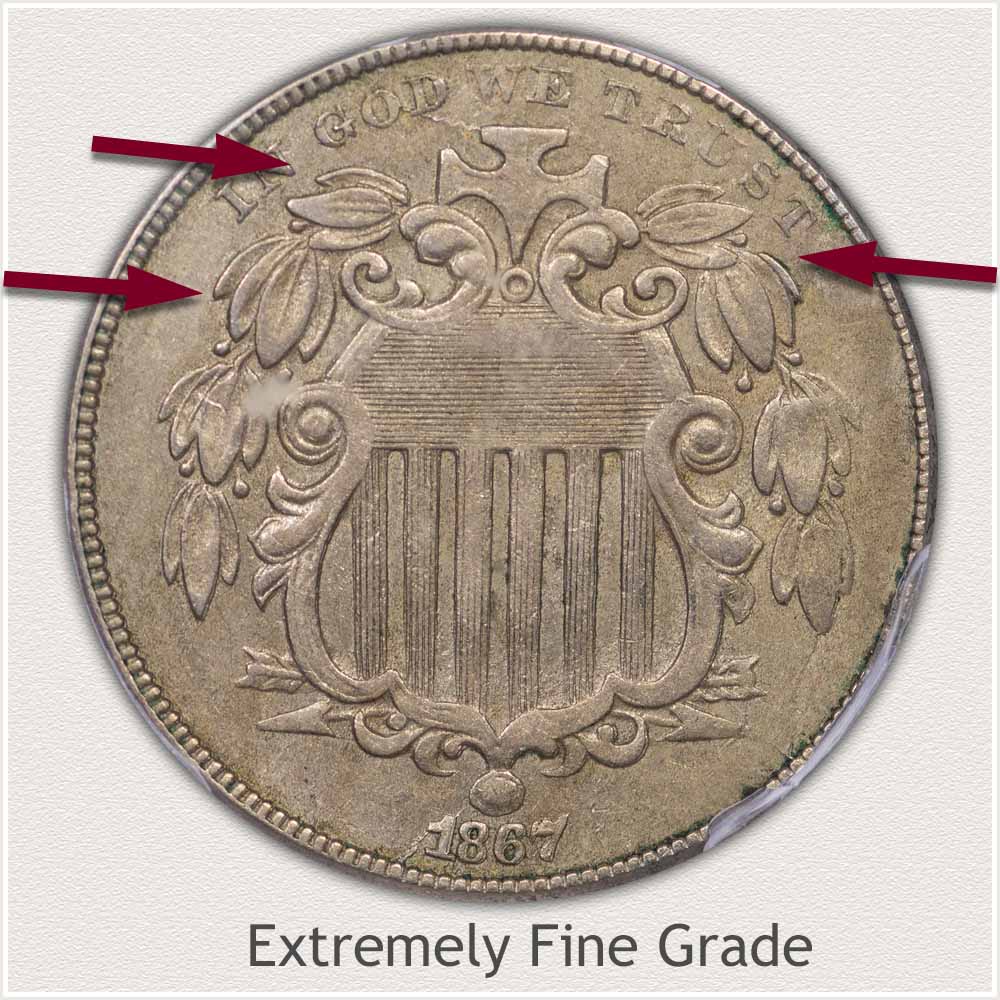
Extremely Fine: Light wear only on high points defines a Shield nickel in Extremely Fine grade. A sharp, crisp amount of detail remains on these high-quality coins. Inspecting areas on the leaf elements is useful in recognizing the amount of wear. These measurements of wear judge condition and grade rating.
Olive branches with leaf clusters extend either side of the central shield. The example nickel, professionally graded Extremely Fine, shows traces of wear on the leaves. Inspecting the left side of the image, note the veins and stems are very bold. Wear on the leaves shows only at the tips and raised edges of the leaves. Typically, the greatest wear is on the topmost leaf of each group of leaves. Moving downward, the three remaining groups are very detailed. On upper-level leaves only the very tips show wear. Strong central veins and edges describe the amount of detail on these leaves.
Due to a softer strike on the right side, less detail shows within the leaves. The right-side leaves display minor fading, but importantly, leaf edges are visible. Central areas of the leaves received less detail when minted and have a soft appearance. However, full edges and central veins remain, but are faint. Use the stronger side of your coin during the evaluation. The better struck elements give an accurate measurement of the amount of wear.
With these grading metrics for the leaves in mind, judge the entire design. On the shield, raised contours remain on the curves and round areas. Minor flatness is only visible on the highest ridges.
Fine Grade
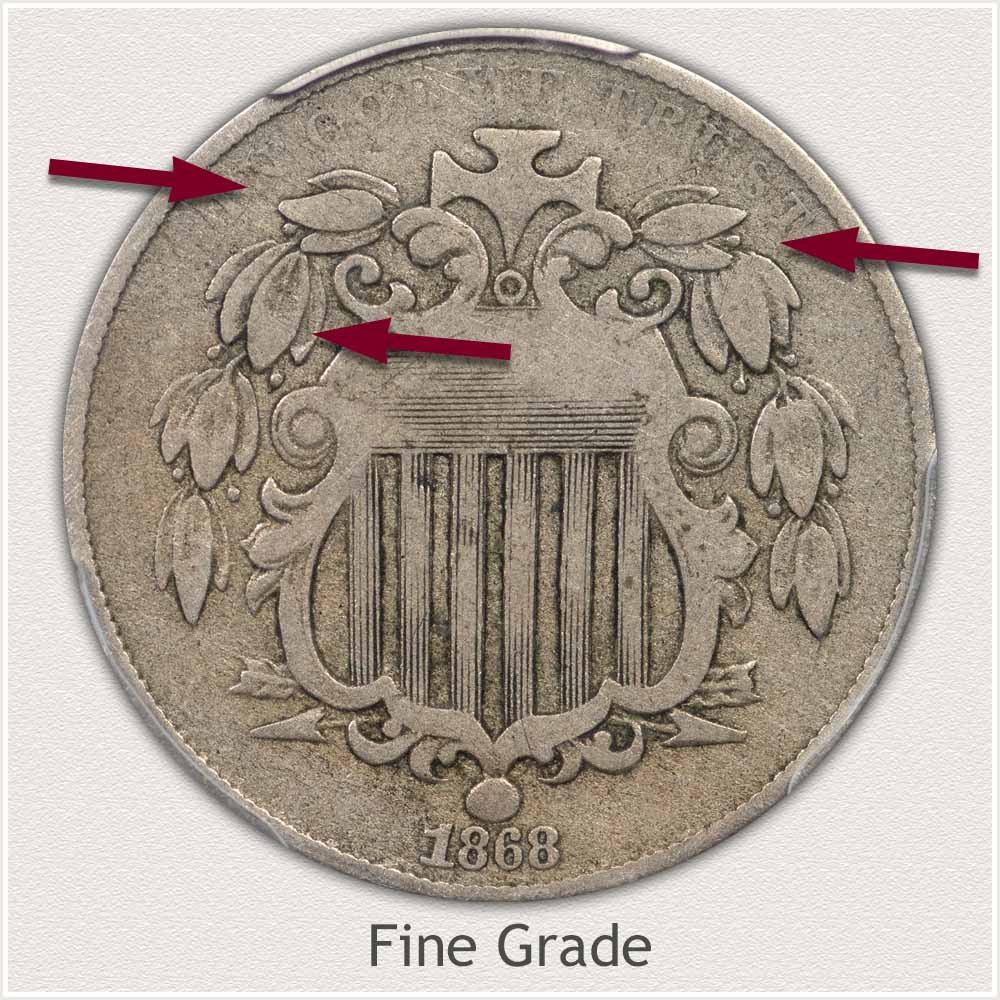
Fine Grade: A Shield nickel in Fine grade has a moderate amount of detail remaining. The leaves of the olive branches provide many areas to inspect and judge condition. High and low contours are part of the leaves. Using leaf edges overlapping lower areas measure the amount of wear on the coin.
Examine the image of a Fine grade nickel. Starting with leaves at the top left, the uppermost leaf is smooth. Importantly, its edge remains separate from lower leaves. On the next group of leaves, wear smooths only half way from the tip. Again, its edges are very bold where they overlap lower leaves.
Begin to compare your coin with the image, and follow these inspection points along the left side. Confirm details within the center of the leaves remain. Gauge the flat areas are only the tips and high ridges of the leaf edges. Most of the center veins remain visible.
Of note: the right-side branch typically shows slightly less detail within the leaves. The top two leaf clusters on the right side often have completely flat upper leaves. Continue the comparison of your coin to the image. You soon notice these subtle features on Shield nickels. An overall view of the condition is a balance of wear and fine detail. Without any large marks or nicks disturbing the surface, these are quality collectibles.
Good Grade
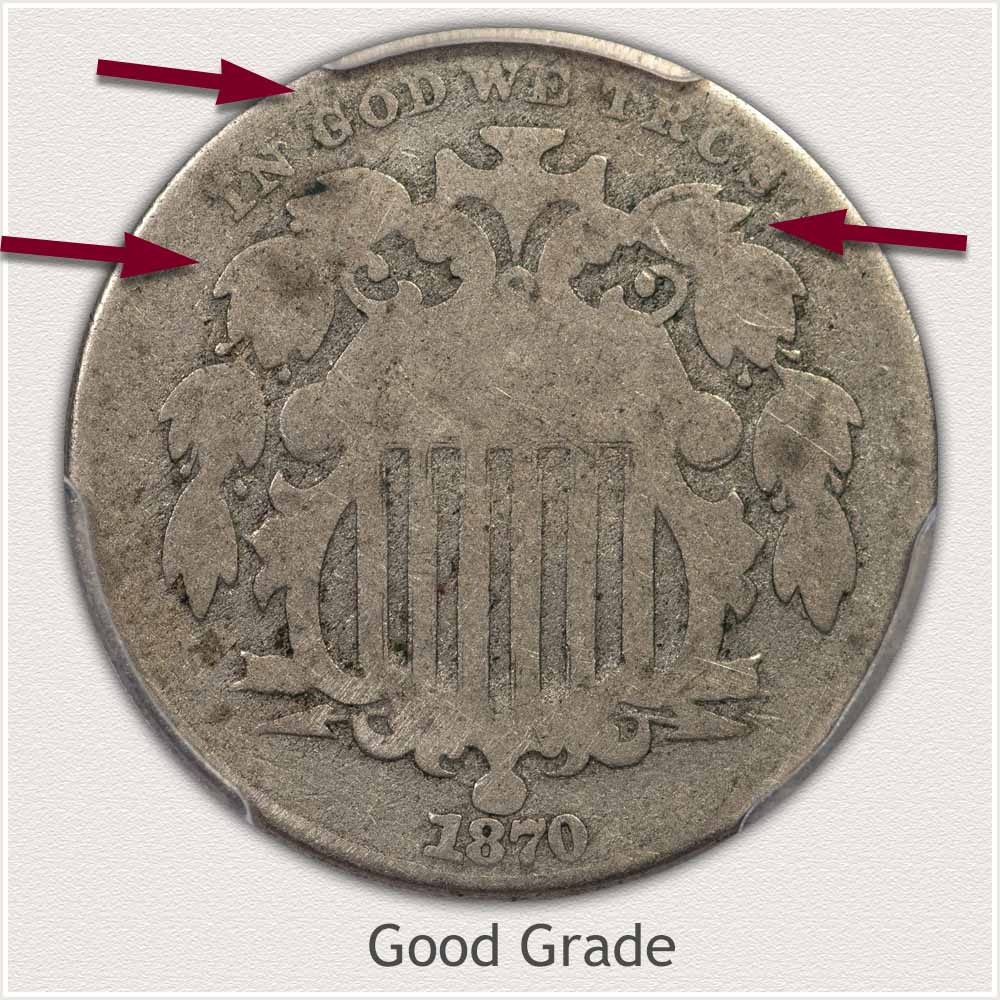
Good Grade: Heavy wear is the overall impression of these coins. One key feature begins to identify a Shield nickel in "Good" grade condition. When major designs are flat, and only outlines remain, this indicates the grade level. On the obverse, a large shield displays no fine detail, although the outer edges of the shield are strong. Either side of the shield, edges of the leaves are also strong. No inner detail of either the shield or leaves defines the Good grade.
On many nickels of the time, an uneven strike was normal when minting these coins. The example illustrates this unevenness along the rim. The heavy wear leaves parts of the rim faint or missing. Only near the date does the rim rise above the field. To quality at the grade level, most of "In God We Trust" remains visible. Fading of the lettering is limited to the upper half.
Moving inward from the rim, all outer edges of the leaves are bold and separate from the field. Inner edges of the leaves, next to the shield, are also complete. Each group of leaves is now one outlined feature. Also, a full cross is above a fully outlined shield device. These qualities must remain when assigning the Good grade to a Shield nickel.
Missing fine details narrows the grade range. Full edges, defining major elements, confirms the Good grade. This coin circulated until just before the entire design faded into the field. It does however present a pleasing appearance with its bold outlines. Lacking deep scratches or marks, it remains in collectible condition.
How to Video: Grading Shield Nickels
Step 3: | Special Qualities | Recognizing the Special Variety
A Design Change and Creation of a Scarce Variety 1867 Nickel
Soon after 1867 nickel coinage began, the Philadelphia mint changed the reverse design. Removing an intricate set of rays between the stars. As a major change to the design, there are now two collectible varieties of 1867 nickels.
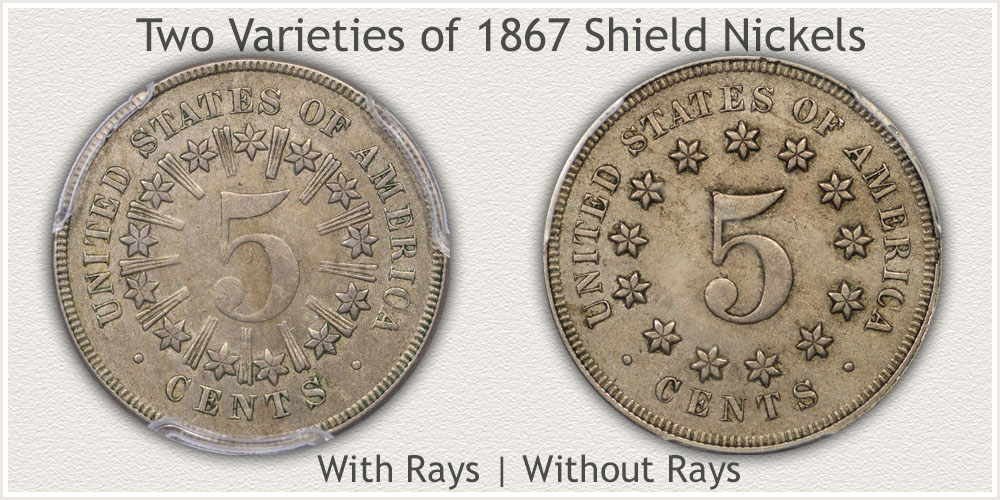 Reverse Designs With Rays and Without Rays of 1867 Shield Nickels
Reverse Designs With Rays and Without Rays of 1867 Shield Nickels
The original reverse became known as "With Rays." Philadelphia modified this design to improve production quality. Both the 1866 nickel, and the "With Rays" variety of the 1867 nickel enjoy demand from collectors. They represent a retired variety. As listed on the value chart, special interest boosts demand and supports nice premiums.
"Without Rays" became the term used when referring to the new reverse. Thirteen stars were no longer combined with ray devices. This less intricate reverse continued through the rest of the Shield Nickel series. This new 1867 nickel variety is also popular, representing a second variety for the year.
Condition is what plays a large role in value of the two varieties. Heavily worn examples of each are abundant when compared to highly detailed examples. Nice condition pieces, of the "No Rays" 1867 nickel are the most difficult variety to find today. It is an important coin to recognize; their listed values reflect this scarcity.
References
U.S. Mint. Catalogue of Coins of the United States
https://nnp.wustl.edu/library/book/554591
U.S. Mint. 1888 U.S. Mint Annual Report
https://nnp.wustl.edu/library/book/313
Coin Values | CoinStudy Articles
Date by Date
In Depth Shield Nickel Value
Shield Nickel Value | Complete Value Chart of All Years
Sixteen different years of Shield Nickels went into circulation. 1867 is among the dates popular with collectors. When comparing premiums of all dates, it becomes notable all are scarce.
How to Grade Shield Nickels | Visual Guide
Judging the condition of an 1867 Shield nickel is especially important. The value chart lists significant differences form one grade to the next. A range of grades are presented in the video, indicating features to examine. Subtle details are highlighted for specific requirements to meet the various grades. With images to illustrate important points, arrive at a conservative judgment of condition.
Selling Coins | A Defined Process
Collectors often sell coins as part of building and improving their collections. Following a process, they first establish values, and judge the strength of the market. Next, they seek dealers specializing in coins like those being sold. First step, organize your holdings. Then review and follow the best practices when selling coins.
Safe Coin Storage | Recommendations
Coin supplies recommended. These are specifically designed for the coin hobby. Each safely hold and preserve coins. A few supplies organize a box of old coins and store them for the long term.
Popular Coin Series | Solid Value Shield Nickels
With a swing in popularity, collecting Shield Nickels has upward potential. Charts illustrate popularity rankings of coin collections using registry set data. Dollar series, Morgan, Peace, and Presidential dollar sets are among the favorites today. Shield nickels are an area of collecting with overall scarcity and potential.
★Coin Values Discovery finds 1867 Nickel Value and...
All old U.S. coin values. It is an excellent index with images and text links to all coin series, from Cents to Gold. Value charts, along with a step-by-step process, uncovers how much your box of old coins is worth. Verify each coin's series, date, and special qualities.
